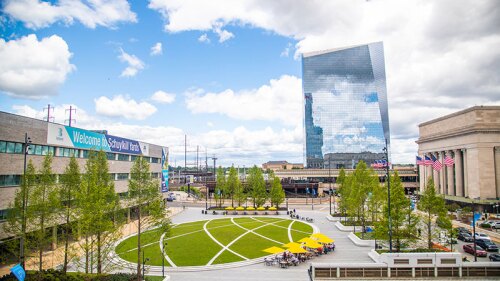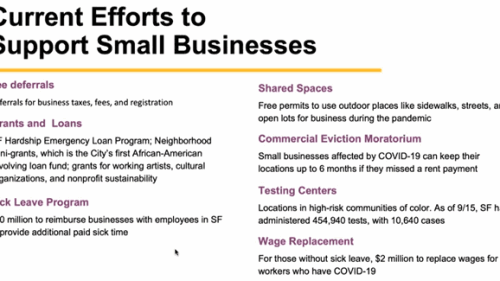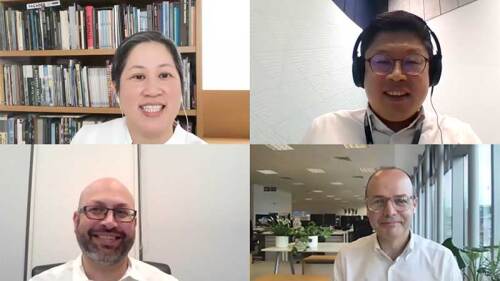The importance of creative placemaking—the process of intentionally integrating arts, culture, and community-engaged design into comprehensive community development—and the role that artists play in that process have been elevated by both the COVID-19 pandemic and social justice protests in the United States, as people seek places to socialize and connect with others outside their homes, according to participants in a recent webinar hosted by ULI’s Building Healthy Places Initiative.
The webinar, “Creative Placemaking in the Time of COVID-19,” explored how creative placemaking has evolved over the past months as a strategy to create new opportunities for socially distanced community gathering and engagement as well as to draw attention to injustice and amplify diverse voices. The presentation was part of a series of webinars offered by the Building Healthy Places Initiative to explore how various aspects of the real estate industry are being affected by the virus and the industry’s response. A recording of this webinar is available on demand in Knowledge Finder.
Moderated by Ben Stone, director of arts and culture for Smart Growth America in Washington, D.C., the presentation featured Jamie Bennett, executive director of ArtPlace America, a New York City–based organization that invests in artist participation in community development; Theresa Sweetland, publisher of Public Art Review and executive director of Forecast, a public art and artist advocacy organization in St. Paul, Minnesota; Juanita Hardy, managing principal, Tiger Management Consulting Group LLC, a real estate and community development consulting firm in Silver Spring, Maryland; and Andrea Jenkins, a Minneapolis City Council member.
Creative Placemaking in Transportation and Community Development
Stone began the webinar with an overview of Smart Growth America’s efforts to connect artists with the creation of public spaces—specifically, transportation projects—pointing out that artists can enliven the projects, catalyze community engagement, help overcome design obstacles, and make streets safer by providing a creative perspective that might not otherwise be considered.
“Many transportation problems are entrenched. We need new solutions, and artists have helped with that,” he said. The impact of COVID-19 on transit systems—creating a situation in which transit officials had to scramble for quick solutions to keep workers and users safe—has amplified the contribution that artists make in improving spaces used for transportation, he said.
“In thinking about spaces and streets, one challenge is how to keep people safe in a system designed to hold larger groups in small spaces. There is a role for artists to play in thinking about behaviors and culture change and how we relate to one another in public spaces,” Stone said.
According to Bennett of ArtPlace America, 10 interlocking systems make up community development: agriculture and food, economic development, education and youth, the environment, health, housing, immigration, public safety, transportation, and workforce development. Of these, creative placemaking is likely most directly related to health and public safety, he said, noting that exposure to art through placemaking can help mitigate collective trauma, racism, social exclusion, mental health issues, and chronic disease—all issues elevated in recent months. Bennett cited several examples of this, including the following:
- Broadway Housing Communities in upper Manhattan, which has built supportive housing for families that have experienced homelessness. At the center of the development is Sugar Hill Museum, a museum of art and story telling that helps children overcome the trauma of homelessness through story telling.
- Efforts by artist Hanna Drake in Louisville, Kentucky, to “reclaim the narratives” of billboards in an underserved neighborhood by replacing negative messages with positive, inspirational images and messages.
- The Juxtaposition Arts organization in Minneapolis, which quelled gun violence on a troubled street corner by installing a bubble machine on the roof of a building to distribute bubbles throughout the area. The tactic stopped the violence without militarizing the neighborhood.
- And, the People’s Paper Co-op, a project of the Villages of Arts and Humanities in Philadelphia, which helps women who have completed prison terms reenter society. The project assists them with criminal record expungement and by creating “reverse mug shots” that show them expressing their hope for the future, rather than despair over the past.
Each of these is an example of how the arts community can help transform liabilities into assets and revitalize high-crime places, redefine policing around community building, support justice-involved community members, and foster opportunities for young people in high-crime neighborhoods, Bennett noted. “The knowledge, skills, and abilities of artists can and should be used to foster equitable community development,” he said.
Impact on Artists and Work in Minneapolis
Sweetland discussed how Forecast partners with artists who work in public spaces and how the nonprofit group supports their creative innovation. “These are artists working with public and private partners, urban planners, architects, and neighborhood groups—they have a unique skill set, and we are committed to supporting them,” she said, noting that while Forecast has focused primarily on artists in the Midwest, it is expanding its reach nationally and globally.
The organization, which places particular emphasis on artists of color, connects artists to opportunities by commissioning artists and curating projects that could benefit from art; and by assisting artists with program planning and community engagement activities, she said. In addition, Forecast seeks to have the artists involved early the placemaking process, rather than later.
“Too often, artists are brought in at the end of a project only to create a product, rather than being included as an integral part of the project. We believe the sooner they can be brought in, the more successful, creative, and inclusive the project will be,” Sweetland said.
Even though COVID-19 and the protests have highlighted the need for art-inspired places, she noted that many artists—particularly Black artists and others of color—have lost work during the pandemic and are struggling to make ends meet. In addition to being economically devastated, many have experienced emotional and physical devastation resulting from systemic racism as well as the virus, she said, noting that artists in Minneapolis protested the killing of George Floyd by creating murals and other works of arts in public spaces. “Artists of color want justice, they want to have their histories and culture represented, and they want greater equity in future development,” she said. “Despite all these challenges, artists are creating, innovating, and leading in our country. They are our partners as we heal and rebuild. They want to spread messages of hope.”
Jenkins, the Minneapolis City Council member, noted that the intersection of 38th and Chicago streets in Minneapolis—the place where George Floyd was murdered—is the center of the ward she represents, which includes four neighborhoods that converge where the streets cross. The city is engaging artists and community residents to envision an appropriate memorial at the intersection that reflects the tragedy and the ensuing racial equity movement that it sparked, she said.
For the past 20 years, creative placemaking principles promoting social equity have been applied at the intersection and throughout the surrounding neighborhoods, including projects that showcase local artwork on every block and special events on a bridge that had historically divided the neighborhoods to instead reconnect them, Jenkins said. “We are doing all this creative placemaking work, and yet [the killing of] George Floyd still happened right at that intersection where all this work has been going on. We have to dig deeper than creative placemaking. The role of arts is important, and artists can help us get to the soul of a community. But we need transformational social change, and all of us can play a role in that—in creating a society with equity at center,” she said.
The City Council is reimagining how public safety is provided in the city, she noted. “Rather than defunding the police, I like to think of it as re-funding our communities. And a lot of that will be about what our built environment will look like. We need creative solutions for designing buildings with healing and equity in mind. That is going to be the future of creative placemaking,” Jenkins said.
Arts and Real Estate Development
Creative placemaking is “more relevant than ever,” said Hardy of Tiger Management Consulting. “The pandemic has brought about a lot of change very fast. People want togetherness in this time of social distancing, but they want to be safe. People will go out and move about if they can be assured of safety and wellness. All of this suggests a new set of products in the built environment to address these needs.”
According to Hardy, open spaces that reflect the tenets of creative placemaking will continue to be in high demand, as people seek places to gather where they can interact while keeping a safe distance from each other. In addition, places that are enlivened by public art can help promote healing from the racial unrest and serve as a response to calls for social equity and inclusivity throughout the nation, she said, noting that art and culture serve both as components of a healthy, thriving place and as a strategy to achieve it.
“Creative placemaking is a tool for building equitable communities,” Hardy said. She pointed to several best practices for creative placemaking, including the following: Begin with the end in mind; bring in artists and the community upfront; mine local art and cultural assets; understand and articulate stakeholder benefits; form cross-sector partnerships; look for early wins; and maintain a long view.
According to Hardy, one example of a development that is illustrative of these practices is Downtown South in Raleigh, North Carolina, a $2 billion mixed-use development that is envisioned to be a major gateway to the city’s downtown. The developer, aided by advice from a ULI Advisory Services panel, is addressing concerns over displacement of existing residents by engaging residents in creating an inclusive, equitable development plan and making sure that local art and culture are central to the plan. She also cited the $250 million Brickline Greenway in St. Louis, a pedestrian and bicycle trail system that will wind through and connect nearly 20 neighborhoods in the city, with a special emphasis on reaching underserved areas. Local artists were recruited to work with other community stakeholders on incorporating art throughout the greenway, which will include a memorial to a neighborhood razed decades ago by urban renewal.
“This is the kind of placemaking that helps healing, that recognizes the past and brings people together,” Hardy said. Other examples, she added, are in ULI’s publication Creative Placemaking: Sparking Development with Arts and Culture.
For more information related to COVID-19 and real estate, visit Public Health and Real Estate: Resources on COVID-19 at uli.org.
TRISH RIGGS, former senior vice president of communications at ULI, is a freelance writer based in Falls Church, Virginia.



